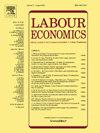养老金缴纳差距的不平等
IF 2.6
2区 经济学
Q2 ECONOMICS
引用次数: 0
摘要
我们研究了社会保险缴费差距在不同收入分配中的差异。这些缺口除了减少养老金缴款外,还会对工人产生多重短期影响。通过对智利长达14年的调查,我们发现工资水平最低的两个十分之一的收入者的收入差距要大得多,在控制了广泛的协变量、个体固定效应和应用工具变量之后,这一结果仍然存在。工资十分位数对收入差距的剩余影响是每个工资十分位数的集体属性,可能有助于指导政策。我们还分析了总差距——包括不活动的时期——使用了一个35年的行政小组。总差距频率从最低十分位数的91-90%下降到最高十分位数的26%,差距比其他估计更大。我们从不同的初始收入十分位数开始,进一步测量了20年期间累积总差距的分散程度。最后,我们回顾了通过关闭法定豁免和增加执法预算来减少收入差距的政治动机薄弱的原因。本文章由计算机程序翻译,如有差异,请以英文原文为准。
Inequality in pension contribution gaps1
We examine how gaps in contributions to social insurance vary across the earnings distribution. These gaps have multiple short-term effects on workers in addition to reducing contributory pensions. Using a 14-year panel from Chile, we find that earners in the two lowest wage deciles experience substantially higher gaps, a result that persists after controlling for extensive covariates, individual fixed effects and applying instrumental variables. The remaining incidence of the wage decile on earner gaps is a collective attribute of each wage decile that may help guide policy. We also analyze total gaps—which include periods of inactivity—using a 35-year administrative panel. Total gap frequency declines from 91–90% in the lowest decile to 26% in the highest, a larger inequality than in other estimates. We further measure the dispersion of cumulative total gaps over a 20-year horizon, starting from different initial earnings deciles. Finally, we review reasons for weak political incentives to reduce earner gaps through closing statutory exemptions and increasing enforcement budgets.
求助全文
通过发布文献求助,成功后即可免费获取论文全文。
去求助
来源期刊

Labour Economics
ECONOMICS-
CiteScore
3.60
自引率
8.30%
发文量
142
期刊介绍:
Labour Economics is devoted to publishing research in the field of labour economics both on the microeconomic and on the macroeconomic level, in a balanced mix of theory, empirical testing and policy applications. It gives due recognition to analysis and explanation of institutional arrangements of national labour markets and the impact of these institutions on labour market outcomes.
 求助内容:
求助内容: 应助结果提醒方式:
应助结果提醒方式:


